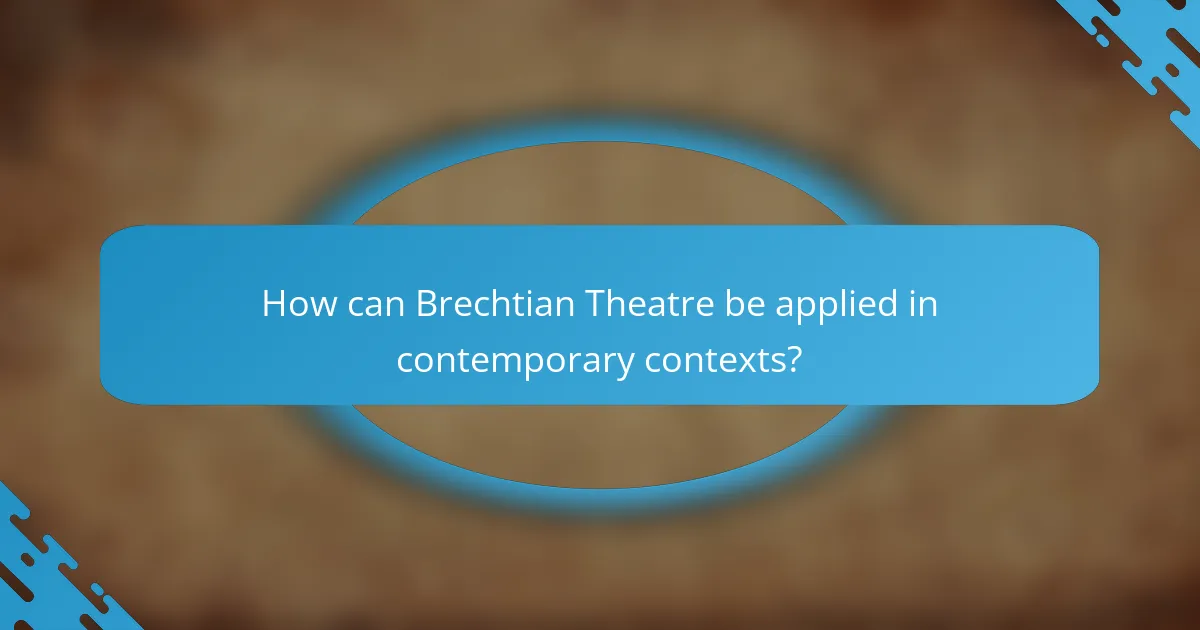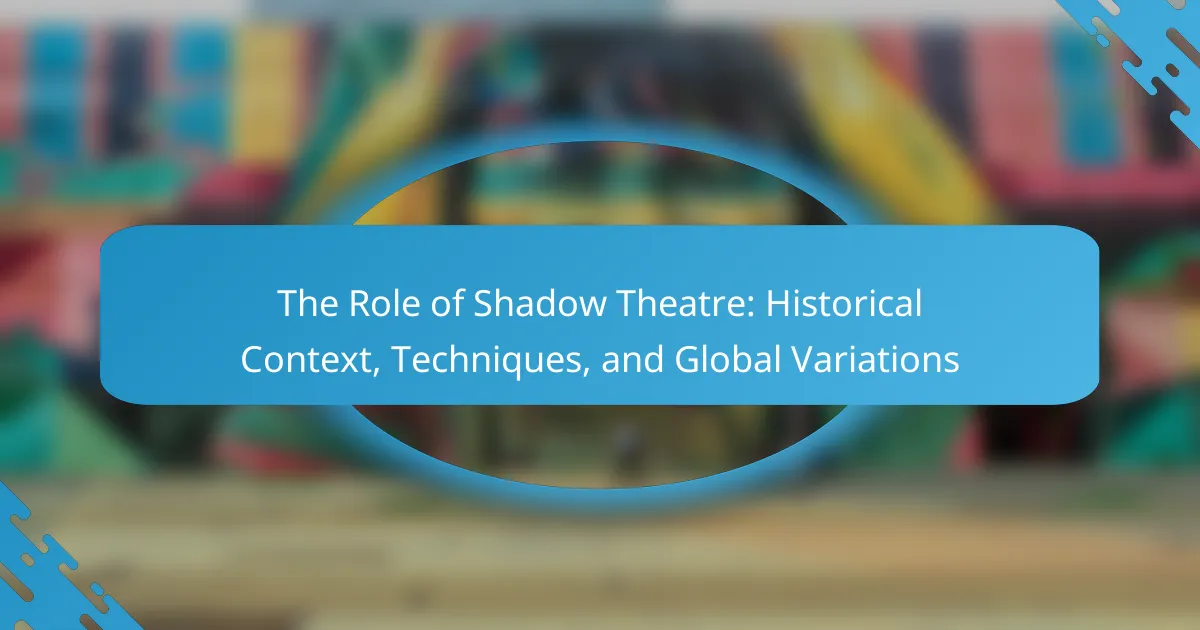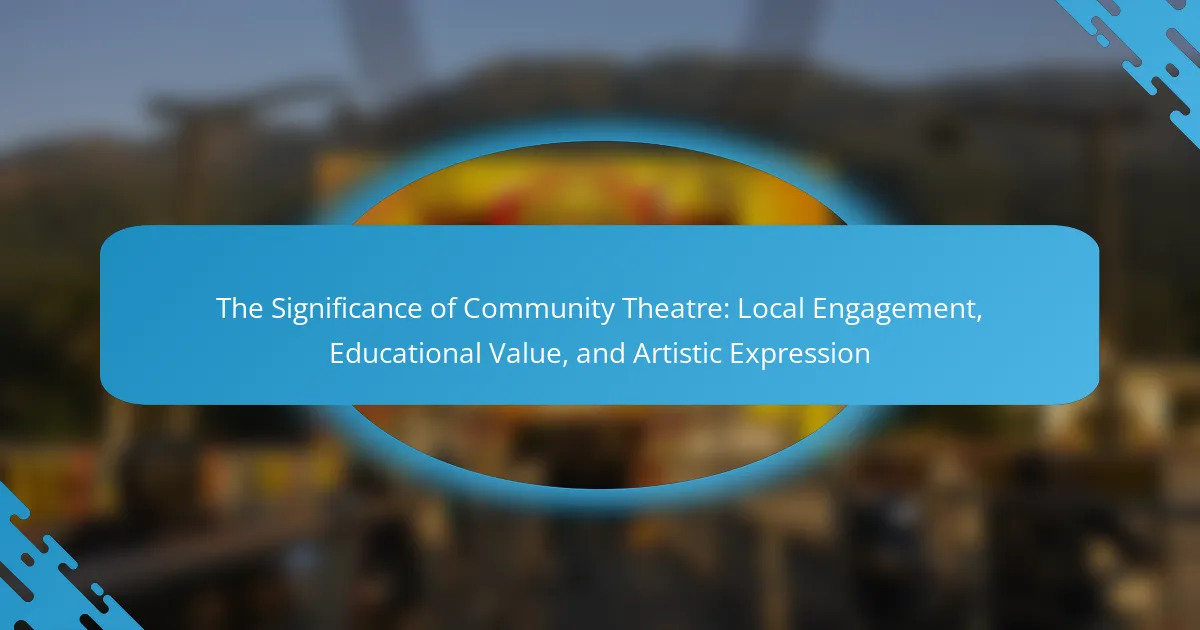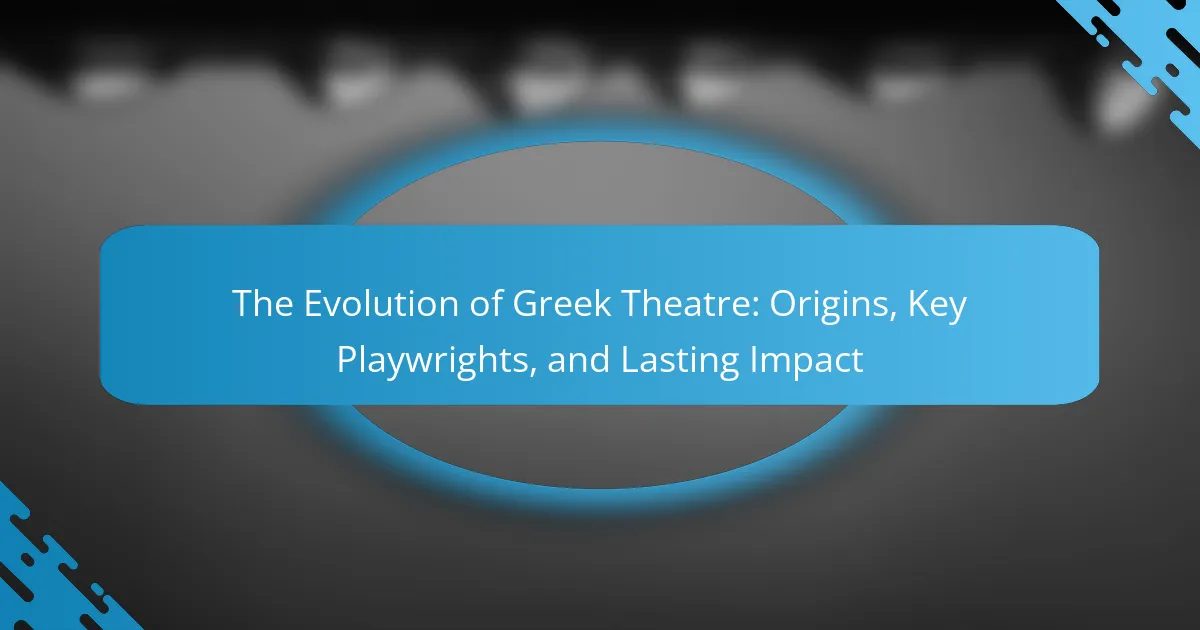Brechtian Theatre is a performance style developed by German playwright Bertolt Brecht, characterized by techniques that promote critical thinking and engage audiences intellectually. Central to this approach is the “Verfremdungseffekt,” or “alienation effect,” which encourages viewers to question the on-stage action rather than emotionally connect with it. Brechtian Theatre often incorporates political themes and social commentary, aiming to inspire social change by highlighting injustices and societal norms. Contemporary applications of Brechtian principles include multimedia elements and community-based projects that address current social issues, ensuring the relevance of this theatrical style in modern contexts.

What is Brechtian Theatre?
Brechtian Theatre is a style of performance developed by German playwright Bertolt Brecht. It emphasizes the use of techniques that promote critical thinking. This form of theatre seeks to engage the audience intellectually rather than emotionally. Brecht introduced the concept of “Verfremdungseffekt,” or the “alienation effect.” This technique encourages viewers to question the action on stage. Brechtian Theatre often incorporates political themes and social commentary. The goal is to inspire social change through awareness. Brecht’s works, such as “Mother Courage and Her Children,” exemplify these principles.
How did Brechtian Theatre emerge and evolve?
Brechtian Theatre emerged in the early 20th century, primarily influenced by Bertolt Brecht’s ideas. Brecht sought to create a form of theatre that would provoke critical thinking in audiences. He developed the concept of “Verfremdungseffekt,” or alienation effect, to disrupt audience immersion. This technique encouraged viewers to engage intellectually rather than emotionally with the performance.
The evolution of Brechtian Theatre occurred through the integration of Marxist ideology and a focus on social issues. Brecht’s works, such as “The Threepenny Opera,” challenged traditional narratives and highlighted class struggles. His techniques influenced modern theatre, promoting political commentary and audience engagement.
By the mid-20th century, Brecht’s methods were adopted worldwide, shaping contemporary theatrical practices. His emphasis on the role of the audience remains significant in modern performances. Brechtian Theatre continues to inspire artists seeking to address social and political themes.
What historical context influenced the development of Brechtian Theatre?
Brechtian Theatre developed in response to the socio-political upheavals of the early 20th century. The rise of fascism and the aftermath of World War I shaped Brecht’s views on art and society. He sought to create a theatre that encouraged critical thinking rather than passive consumption. The economic struggles of the Weimar Republic also influenced his focus on social issues. Brecht’s experiences with Marxist ideology further informed his theatrical techniques. The desire for political engagement led to the development of the Epic Theatre style. This style aimed to provoke thought and inspire action among audiences. Brecht’s work remains a reflection of the historical context in which it was created.
Who are the key figures associated with Brechtian Theatre?
Bertolt Brecht is the central figure associated with Brechtian Theatre. He developed the concept of epic theatre. Brecht emphasized the importance of social and political themes in performance. He sought to provoke critical thinking in the audience. Other key figures include Helene Weigel, Brecht’s wife and collaborator. She played a crucial role in directing and performing his works. Additionally, Erwin Piscator contributed to the development of political theatre. Piscator’s techniques influenced Brecht’s approach to staging and narrative. These figures collectively shaped the principles of Brechtian Theatre.
What are the core techniques used in Brechtian Theatre?
The core techniques used in Brechtian Theatre include alienation effect, direct address, and non-linear narratives. The alienation effect aims to prevent emotional identification with characters. This technique encourages critical thinking about the social and political issues presented. Direct address involves actors speaking directly to the audience. This breaks the fourth wall and fosters engagement with the audience’s awareness. Non-linear narratives disrupt traditional storytelling. This technique challenges the audience to question the cause-and-effect relationships in the plot. Brecht’s methods emphasize social critique and provoke thought rather than emotional involvement. These techniques collectively serve to engage the audience intellectually and politically.
How does the concept of ‘Verfremdungseffekt’ function in performances?
The ‘Verfremdungseffekt,’ or alienation effect, functions in performances by distancing the audience from emotional engagement. This technique encourages critical observation rather than empathy. By breaking the fourth wall, performers remind the audience they are watching a play. Techniques such as direct address and visible stage mechanics disrupt the illusion of reality. Brecht intended this effect to provoke thought and inspire social change. Historical examples include Brecht’s own works, like “Mother Courage and Her Children.” These performances challenge audiences to reflect on societal issues. The ‘Verfremdungseffekt’ thus serves as a tool for political commentary and engagement.
What role does music and song play in Brechtian Theatre?
Music and song play a crucial role in Brechtian Theatre by enhancing the political message and engaging the audience. They serve to interrupt the narrative flow, promoting critical thinking rather than passive consumption. Brecht utilized songs to comment on social issues and provoke reflection. This technique is evident in works like “The Threepenny Opera,” where songs highlight themes of capitalism and morality. The use of music creates a distance between the audience and the performance, aligning with Brecht’s concept of “Verfremdungseffekt” or alienation effect. This approach encourages viewers to analyze the socio-political context rather than becoming emotionally absorbed in the story. Brecht believed that music could evoke an intellectual response, making it an essential tool in his theatrical philosophy.
How does Brechtian Theatre utilize staging and set design?
Brechtian Theatre utilizes staging and set design to create a sense of alienation and critical engagement. The set is often minimalistic, emphasizing the theatricality of the performance. This approach disrupts the illusion of reality, prompting the audience to think critically about the themes presented. Set design may include visible stage mechanics and props to remind viewers they are watching a play. For example, Brecht often used signs and projections to convey information directly. This method encourages spectators to analyze the narrative rather than passively absorb it. By employing these techniques, Brechtian Theatre fosters a space for political commentary and social reflection.

What is the political significance of Brechtian Theatre?
Brechtian Theatre is politically significant as it aims to provoke critical thinking and social change. This form of theatre challenges traditional narratives and encourages audiences to question societal norms. Brecht employed techniques such as alienation to disrupt emotional engagement. This method prompts viewers to analyze the action rather than passively absorb it. By highlighting social injustices, Brechtian Theatre serves as a tool for political commentary. It often reflects the conflicts of its time, such as class struggle and oppression. Historical examples include “Mother Courage and Her Children,” which critiques war and capitalism. Brecht’s approach has influenced modern political theatre, promoting activism through performance.
How does Brechtian Theatre address social and political issues?
Brechtian Theatre addresses social and political issues through its emphasis on alienation and critical engagement. It encourages audiences to question societal norms rather than passively absorb the narrative. This technique, known as Verfremdungseffekt, disrupts emotional immersion. It prompts viewers to analyze the social conditions presented on stage. Brecht believed theatre should serve as a platform for political discourse. His works often highlight class struggle and social injustice. For example, “The Threepenny Opera” critiques capitalism and its impact on morality. Brecht’s methodologies invite reflection on systemic issues, promoting awareness and potential change.
What themes are commonly explored in Brechtian works?
Brechtian works commonly explore themes of social injustice, alienation, and the critique of capitalism. Social injustice is often highlighted through characters facing oppression and inequality. Alienation is used to disconnect the audience from emotional engagement, prompting critical thought. The critique of capitalism manifests in narratives that expose economic disparities and class struggles. Other themes include the role of the individual in society and the impact of war. Brecht’s techniques, such as the Verfremdungseffekt, reinforce these themes by encouraging viewers to question societal norms. Historical contexts, such as the rise of fascism, further influence these thematic explorations in his works.
How does Brechtian Theatre challenge traditional narratives?
Brechtian Theatre challenges traditional narratives by employing techniques that disrupt audience immersion. It uses the concept of “Verfremdungseffekt,” or alienation effect, to make familiar situations seem strange. This technique encourages critical reflection rather than emotional engagement. Brecht’s works often feature non-linear storytelling and episodic structure, which contrasts with conventional plot development. Additionally, Brecht incorporates direct address and commentary, breaking the fourth wall. This engages the audience in political discourse rather than passive consumption. Historical examples include “Mother Courage and Her Children,” which critiques war and capitalism. Brecht’s methods aim to provoke thought and inspire social change.
Why is audience engagement important in Brechtian Theatre?
Audience engagement is crucial in Brechtian Theatre because it fosters critical thinking among viewers. Brecht aimed to create a sense of awareness and reflection in his audience. He used techniques like the alienation effect to disrupt passive viewing. This approach encourages spectators to question societal norms and injustices. Engaging the audience transforms them from passive observers to active participants. Historical context shows that Brecht’s methods were designed to provoke dialogue about political and social issues. As a result, audience engagement becomes a tool for social change and empowerment. Brecht believed that theatre should not just entertain but also educate and inspire action.
How does Brechtian Theatre encourage critical thinking among audiences?
Brechtian Theatre encourages critical thinking among audiences by employing techniques that disrupt traditional narrative forms. It utilizes the concept of “Verfremdungseffekt” or alienation effect. This technique prevents emotional identification with characters. Instead, it prompts viewers to analyze the social and political contexts presented. Brecht aimed to provoke reflection on societal issues through theatrical devices. For instance, the use of direct address breaks the fourth wall. This engages the audience in a dialogue about the themes. Additionally, the incorporation of multimedia elements challenges passive viewing. These strategies collectively foster an environment for critical engagement.
What techniques are used to disrupt audience passivity?
Techniques used to disrupt audience passivity include alienation effect, direct address, and interactive elements. The alienation effect encourages critical thinking by preventing emotional immersion. This technique prompts audiences to reflect on the performance rather than becoming passive observers. Direct address involves actors speaking directly to the audience, breaking the fourth wall. This method fosters engagement and challenges the audience’s role. Interactive elements invite audience participation, creating a dynamic experience. For instance, Brecht’s plays often included audience polls or discussions. These techniques collectively aim to provoke thought and inspire action, aligning with Brecht’s political objectives.

How can Brechtian Theatre be applied in contemporary contexts?
Brechtian Theatre can be applied in contemporary contexts through techniques that promote critical thinking. This includes the use of alienation effects to prevent audience identification with characters. For example, actors may break the fourth wall to address the audience directly. This technique encourages viewers to question the narrative rather than passively consume it.
Contemporary productions often incorporate multimedia elements, such as projections and soundscapes, to enhance the alienation effect. This approach aligns with Brecht’s emphasis on the socio-political context of the performance. Productions can address current social issues, such as climate change or inequality, through Brechtian methods.
Additionally, community-based theatre projects utilize Brechtian principles to engage local audiences in dialogue. These projects often reflect the specific concerns of the community, fostering a sense of agency among participants. Overall, Brechtian Theatre remains relevant by adapting its techniques to resonate with modern audiences and issues.
What modern adaptations of Brechtian Theatre exist today?
Modern adaptations of Brechtian Theatre include immersive and interactive performances. Companies like Punchdrunk and Complicité utilize audience participation. These adaptations often highlight social and political issues. They encourage critical thinking among viewers. Additionally, contemporary works incorporate multimedia elements. This includes video projections and digital soundscapes. Productions like “The Encounter” by Complicité exemplify this trend. They engage audiences in a unique, thought-provoking manner. These adaptations maintain Brecht’s original intent of provoking social change.
How do contemporary playwrights incorporate Brechtian techniques?
Contemporary playwrights incorporate Brechtian techniques by emphasizing social critique and audience engagement. They often use techniques like the alienation effect to prevent emotional identification with characters. This encourages viewers to think critically about the issues presented. Additionally, they may employ multi-media elements and direct address to break the fourth wall. Such methods prompt audiences to participate actively in the narrative. Playwrights like Sarah Kane and Tony Kushner have utilized these strategies to highlight political themes. Their works challenge societal norms and provoke thought. This integration of Brechtian techniques enhances the relevance of contemporary theatre.
What challenges do modern productions face in maintaining Brechtian principles?
Modern productions face significant challenges in maintaining Brechtian principles. One challenge is the prevailing preference for realism in contemporary theatre. This focus often contradicts Brecht’s emphasis on alienation and critical engagement. Another challenge is the commercial pressures of the theatre industry. These pressures can lead to the dilution of political messages in favor of mass appeal. Additionally, the complexity of Brecht’s techniques requires skilled practitioners. Many modern actors and directors may lack the training necessary to effectively implement these methods. Furthermore, audience expectations have shifted over time. Today’s audiences often seek emotional immersion rather than the critical distance Brecht advocated. These factors collectively hinder the faithful application of Brechtian principles in modern theatrical productions.
What best practices can be followed when producing Brechtian Theatre?
Best practices for producing Brechtian Theatre include emphasizing the alienation effect. This technique encourages audiences to critically engage with the performance rather than becoming emotionally absorbed.
Another practice is using direct address to the audience. This breaks the fourth wall and prompts viewers to reflect on the themes presented.
Incorporating multimedia elements enhances the message. Projections and sound can underscore key ideas and provoke thought.
Utilizing non-linear narratives challenges traditional storytelling. This approach encourages audiences to question the progression of events and their implications.
Employing minimalistic staging focuses attention on the content. Simple sets and costumes can highlight the message over spectacle.
Encouraging audience participation fosters engagement. Interactive elements can deepen the connection to the political themes explored.
Finally, ensuring a strong political message is central. Brechtian Theatre aims to provoke social change and inspire action. Each performance should reflect relevant societal issues.
How can directors effectively implement Brechtian techniques in their productions?
Directors can effectively implement Brechtian techniques by emphasizing the concept of alienation. This technique encourages the audience to critically engage with the performance rather than becoming emotionally absorbed. Directors should utilize direct address, breaking the fourth wall to create a dialogue with the audience. They can incorporate multimedia elements like projections or live video to disrupt the narrative flow.
Additionally, directors should encourage actors to deliver lines in a way that highlights the constructed nature of the performance. This can involve varying tone and pace to provoke thought. Using minimal set designs can also help maintain focus on the story’s political message.
Historically, Brecht’s own productions, such as “The Threepenny Opera,” demonstrated these techniques effectively, prompting audiences to reflect on societal issues. By integrating these methods, directors can foster a space for critical thought and engagement.
What should educators consider when teaching Brechtian Theatre concepts?
Educators should consider the principles of alienation and critical engagement when teaching Brechtian Theatre concepts. Alienation effects encourage audiences to think critically rather than emotionally engage with the performance. This approach aims to provoke thought about social and political issues. Educators should also emphasize the use of non-traditional narrative structures in Brecht’s works. These structures often break the fourth wall, inviting audience participation. Additionally, understanding the historical context of Brecht’s work is essential. Brecht’s theatre emerged as a response to the social and political climate of the early 20th century. This context helps students grasp the relevance of his techniques today. Finally, practical exercises in performance and improvisation can enhance understanding. Engaging students in these activities fosters a deeper appreciation of Brechtian methods.
Brechtian Theatre, developed by German playwright Bertolt Brecht, is a performance style that emphasizes critical thinking and political engagement through techniques such as the alienation effect and direct address. This article explores the emergence and evolution of Brechtian Theatre, its historical context, key figures, and core techniques that challenge traditional narratives. It also examines the political significance of Brechtian works, themes commonly explored, and the importance of audience engagement in fostering social change. Additionally, the article discusses contemporary applications and adaptations of Brechtian principles in modern theatre.



